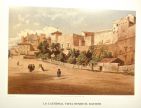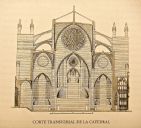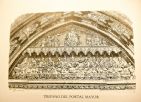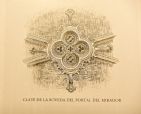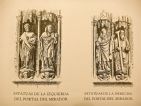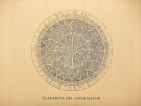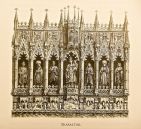
Cathedral
"None of the buildings on the island can compare to the Cathedral in terms of both its grandeur and location. Long before reaching Palma, the first thing we can observe from the sea is the dark hulk of the Cathedral. It was built where the Great Mosque was once found, construction beginning immediately after the city’s conquest, that is, in 1230. Jaume the Conqueror certainly saw the Royal Chapel completed as demonstrated, amongst other things, by the fact that said chapel’s keystones bear his coat of arms. Construction was interrupted at several times and progressed slowly due to political circumstances until Jaume III’s death. However, it’s been demonstrated that the second chapel was already built in 1375 along with the side naves and that, in 1380, the domes of the entire central nave had been finished. The rest was built more slowly, and the facade wasn’t completed until 1560. Since the old main portal was destroyed, it had to be rebuilt. This was verified to have been done in 1601.
The entire building is made of sandstone blocks cut from the quarries in Portals, Cala Figuera, and Teulera near Palma. With time, the stone, especially that on the side facing the sea, has acquired a beautiful golden-yellow patina which gives the entire building great charm. In particular, when the sun is bright, the entire building seems aflame with a very hot and soft hue which only time and the south can transmit to stone.
On the corners, on both sides of the Plateresque main portal, the facade has two towers, a rosette above the main portal and two Gothic windows in lateral slats.
Externally, the Cathedral, or “Seu”, has eight buttresses on each side, divided in between by four cornices, one of which serves to finish it. The side facing out is decorated with molding. The main nave is joined to these buttresses by light flying buttresses crowned by two pinnacles. Only the upper flying buttresses have no roof; the lowers ones, used to support the side chapels, are covered by a roof.
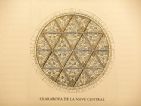 The rosette in the main name is marvelous as is the one above the main apse, behind the retrochoir chapel which, in addition, has three large windows on either side. The majority of the windows have been walled up and only have three portholes open in the upper arches.
The rosette in the main name is marvelous as is the one above the main apse, behind the retrochoir chapel which, in addition, has three large windows on either side. The majority of the windows have been walled up and only have three portholes open in the upper arches.
The Cathedral’s three portals are particularly very pretty: the main portal is Plateresque in style, while the two side portals are Gothic.
A true masterpiece is the portal on the right, called the Portal del Mirador and whose doors open into a domed atrium after a very tall arch decorated with foliage, crucifers and two pinnacles where the arch starts. The dome’s keystone is very graceful, where the ribs join simply. The portal itself has an elevated frontispiece which is richly decorated with foliage and crucifers over a triple arch. In the empty space between them and below are two small statues of saints and angels between small canopies. The reliefs on the tympanum are very fine work, featuring, God the Father on the top part surrounded by adoring angels. The Holy Supper is on the lower part. The double dour is divided by a very elegant, small pillar holding up a statue of the Mother of God with Baby Jesus. The portal on the left, called Portal de l’Almoina, though much simpler, has a very noble design. Its great arch penetrates the wall featuring foliage and a florid cross as decoration on the top part, along with thin columns which end in small pinnacles and are joined together by a blind Gothic frieze.
Next to the Portal de l’Almoina and attached to the fifth buttress is the bell tower. The latter is divided into three parts separated by corbels sustained by cantilevers.
 After focusing on the Cathedral’s exterior, we now turn our attention to its interior. The first impression upon entering is produced by its enormous naves and lightness. It’s all built of greyish sandstone blocks. It has three naves. The central and main one measures 156 feet up to its domes, and the two side ones are shorter. Seven tall and fine octagonal columns on each side support the domes with surprising lightness. Their bases, also octagonal, are surrounded by three moldings. On one of the columns on the right is a plaque with an inscription recalling the greatest flood the city of Palma has ever suffered.
After focusing on the Cathedral’s exterior, we now turn our attention to its interior. The first impression upon entering is produced by its enormous naves and lightness. It’s all built of greyish sandstone blocks. It has three naves. The central and main one measures 156 feet up to its domes, and the two side ones are shorter. Seven tall and fine octagonal columns on each side support the domes with surprising lightness. Their bases, also octagonal, are surrounded by three moldings. On one of the columns on the right is a plaque with an inscription recalling the greatest flood the city of Palma has ever suffered.
The side naves on the external side have eight Gothic chapels equal in size and not very deep, forming a type of domed and raised niche. Their ribs end in thin pillars which rest on imposts. The fourth chapels on either side aren’t really such. On the right there isn’t even a chapel, rather, an empty wall to which the magnificent Portal del Mirador is attached. Its portico, upon entering the church, forms a true external chapel. In the one on the left, four steps lead to the Portal de l’Almoina which has a simple rosette above.
 The door on the right leads to the chapter house which we will talk about later.
The door on the right leads to the chapter house which we will talk about later.
The two side naves end in very tall chapels which, however, do not even reach half the height of the main altar chapel. Both have pointed arches and Gothic domes whose large keystones are shaped like roses. In the one in front, the arches cross simply, while there are six ribs in the back one as occurs in the other chapels. A reddish marble balustrade separates these two chapels and the other chapels from the rest of the church.
 The chapel on the right, dedicated to Saint Peter, serves as the tabernacle. It has a large, classic altarpiece, made recently in Rome, and the very simple tomb of the last Bishop of Mallorca, Miquel Salvà. In the chapel on the left, the Capella del Corpus Christi, the very rich Plateresque altarpiece is marvelously sculpted. There is also a beautiful Gothic tomb in this chapel where the remains of Bishop Tortella lay. The urn with the prostrate figure of the bishop is inside a very pretty Gothic niche. Ramón de Tortella or de Torruella and his brother, Berenguer de Santa Eugènia, accompanied King Jaume I in his conquest of the island.
The chapel on the right, dedicated to Saint Peter, serves as the tabernacle. It has a large, classic altarpiece, made recently in Rome, and the very simple tomb of the last Bishop of Mallorca, Miquel Salvà. In the chapel on the left, the Capella del Corpus Christi, the very rich Plateresque altarpiece is marvelously sculpted. There is also a beautiful Gothic tomb in this chapel where the remains of Bishop Tortella lay. The urn with the prostrate figure of the bishop is inside a very pretty Gothic niche. Ramón de Tortella or de Torruella and his brother, Berenguer de Santa Eugènia, accompanied King Jaume I in his conquest of the island.
The main altar chapel, also called the Royal Chapel or Capella Reial, is naturally much more spacious than the other two described. Including the arch at the opening, it has five arches which start from short pilasters supported on Gothic imposts. On these are stone statues representing saints or angels (ten total). These statues face each other. The first two are of David and Isaiah, followed by the Virgin Mary and the Archangel, Saint Gabriel, at the time of the Annunciation. The other six are of angels holding candelabras. Around them is a type of cornice, Arabic in origin, from which ancient tapestries hang. This decoration is continued farther below in a hall of sculpted wood made in a honeycomb pattern and with a golden balustrade. The pointed arches simply cross their ribs in keys with sculpted shields. The apse’s keystone features the four sculpted bars of Aragón. From there, six ribs branch out, the longest ones belonging to the arches in back. There are large Gothic windows in the spaces between the arches. The windows are divided into three fields by thin pillars which end in rich tracery. Only three of the tallest windows have beautiful colored glass. In the others, light only penetrates through small square windows opened within the larger windows. The last large window on the left features a large clock which regulates all ceremonies. The “Seu’s” personnel are characterized by their punctuality, holding mass every half hour from the first light of dawn until midday. In the center of the arch in the main altar chapel, up high, is a skylight in colored glass shaped to form a star.
Behind the main altar is the retrochoir with three arches, lower than the previous ones, and its windows. The central one is square and serves to illuminate this space. This chapel, like the ones in the side naves, has rear screens in the corners which correct up high the rectangular shape of the bottom part. The same occurs in the corners of the Royal Chapel, only there they are higher up off the floor. Behind the Baroque altarpiece of the main altar is a beautiful 13th-century Gothic altar, once serving as the main altar. Some are thinking about bringing it back to its original position. In the middle is the Virgin Mary with Baby Jesus and three figures of saints in their corresponding niches on the side. These are finished with frontispieces separated by fine columns of other figures and overlaying pinnacles.
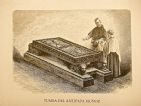 In the middle of this room and under the hat hanging from the dome, signaling it as the chapter house, is the tomb of the Antipope, Gil Muñoz.
In the middle of this room and under the hat hanging from the dome, signaling it as the chapter house, is the tomb of the Antipope, Gil Muñoz.
On the right wall of the first room, with the Antipope’s tomb, is a Baroque portal, with a rounded arch supported on small columns with pseudo-Ionic capitals. The door leads to the cloister referred to as the “Pati de la Font” (Fountain Patio). The cloister is rectangular in shape, and in the middle is the fountain which gives it its name. There are three orange trees in the paved patio. It forms a columned portico with six arches on each of the long sides, with two entrances in the middle and arches supported on columns. The shorter sides of the rectangle only have four arches each. The two terminal columns join in the corner, forming a pilaster. There is a terrace above the portico’s dome, but only the one on the left has a series of small arches with handrails making for a very nice effect. Two small doors in the cloister dating from the late Gothic period merit special mention. They are located on the church side, and one of them corresponds to the bathroom."
Archduke Ludwig Salvator of Austria. Las Baleares por la palabra y el grabado. Majorca: City of Palma. Ed. Sa Nostra, Caja de Baleares. Palma de Mallorca. 1982.









